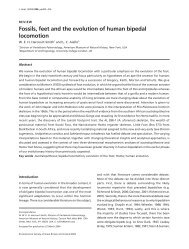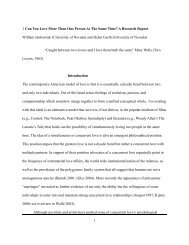Why do humans reason? Arguments for an argumentative theory
Why do humans reason? Arguments for an argumentative theory
Why do humans reason? Arguments for an argumentative theory
You also want an ePaper? Increase the reach of your titles
YUMPU automatically turns print PDFs into web optimized ePapers that Google loves.
Commentary/Mercier & Sperber: <strong>Why</strong> <strong>do</strong> <strong>hum<strong>an</strong>s</strong> <strong>reason</strong>?by different processes. Smith et al. (2009) suggest that interpersonalargumentation in group decisions ch<strong>an</strong>ges goal-specificweights <strong>an</strong>d not the order by which evidence is considered <strong>an</strong>dthus its recall success. M&S find similar differences in implicitinference processes when inferences are made by a single individualor by several individuals in a group setting.In summary, preference <strong>an</strong>d inference tasks seem connected,among other things, by a common <strong>argumentative</strong> nature, whichmay suggest shared cognitive mech<strong>an</strong>isms (Weber & Johnson2009).Reasoning, robots, <strong>an</strong>d navigation: Dual roles<strong>for</strong> deductive <strong>an</strong>d abductive <strong>reason</strong>ing<strong>do</strong>i:10.1017/S0140525X10002955J<strong>an</strong>et WilesSchool of In<strong>for</strong>mation Technology & Electrical Engineering, University ofQueensl<strong>an</strong>d, Brisb<strong>an</strong>e 4072, Australia.wiles@itee.uq.edu.au http://www.itee.uq.edu.au/≏j<strong>an</strong>etw/Abstract: Mercier & Sperber (M&S) argue <strong>for</strong> their <strong>argumentative</strong><strong>theory</strong> in terms of communicative abilities. Insights c<strong>an</strong> be gained byextending the discussion beyond hum<strong>an</strong> <strong>reason</strong>ing to rodent <strong>an</strong>d robotnavigation. The selection of arguments <strong>an</strong>d conclusions that aremutually rein<strong>for</strong>cing c<strong>an</strong> be cast as a <strong>for</strong>m of abductive <strong>reason</strong>ing that Iargue underlies the construction of cognitive maps in navigation tasks.Mercier <strong>an</strong>d Sperber’s (M&S’s) <strong>theory</strong> of the adaptive value of<strong>argumentative</strong> <strong>reason</strong>ing is intriguing from a computational perspective,since the search <strong>for</strong> arguments that support a given conclusionis computationally more difficult (viewed as a <strong>reason</strong>ingproblem) th<strong>an</strong> logical <strong>reason</strong>ing. The first logical solvers weredeveloped in the 1950s (Newell & Simon 1956). Argumentativecomputers are yet to be developed.Argumentative <strong>reason</strong>ing, defined broadly as the discovery ofstatements to support a given conclusion c<strong>an</strong> be cast as a <strong>for</strong>mof adbuctive <strong>reason</strong>ing, or inferring a precondition from a consequent(following Peirce 1931–35). Such <strong>reason</strong>ing is logically fallacious,but as M&S’s target article details, it is typical of hum<strong>an</strong>behaviour to select arguments <strong>an</strong>d conclusions that together aremutually rein<strong>for</strong>cing.We accept M&S’s arguments <strong>for</strong> the adaptive value of <strong>argumentative</strong><strong>reason</strong>ing as a communicative skill. However, just asquestions have been raised in other fields about the evolutionof the sophisticated communicative abilities of <strong>hum<strong>an</strong>s</strong>, we c<strong>an</strong>also ask how <strong>an</strong> <strong>argumentative</strong> ability could have evolved.M<strong>an</strong>y evolutionary adaptations are thought to be exaptations;that is, new uses <strong>for</strong> existing structures. Verbal <strong>argumentative</strong><strong>reason</strong>ing obviously draws on linguistic ability, but it need notpostdate it. We consider the possibility that cognitive abilitiesunderlying <strong>argumentative</strong> <strong>reason</strong>ing may predate the evolutionof l<strong>an</strong>guage by exapting abductive abilities from other <strong>do</strong>mains.Reasoning is not the only <strong>do</strong>main where adaptive behaviourmay utilise abductive <strong>reason</strong>ing. A much more <strong>an</strong>cient evolutionaryability, which <strong>hum<strong>an</strong>s</strong> share with other mammals, birds, reptiles,<strong>an</strong>d even insects, is the ability to navigate. Much is knownabout the navigational systems of mammals, including theneural representations of places (O’Keefe & Dostrovsky 1971)linked into cognitive maps (O’Keefe & Nadel 1978; Tolm<strong>an</strong>1948), grid cells (Moser et al. 2008), <strong>an</strong>d head-direction cells(Taube et al. 1990). Complementing neural studies are computationalmodels <strong>an</strong>d embodied robots, <strong>an</strong>d it is the fully functionalrobotic systems (Arleo & Gerstner 2000; Kuipers 2000; Mil<strong>for</strong>d& Wyeth 2003; Thrun 2003) that provide insight <strong>for</strong> thiscommentary.Two approaches c<strong>an</strong> be contrasted <strong>for</strong> robotic navigationalsystems: a logically correct approach based on Bayesi<strong>an</strong><strong>reason</strong>ing (<strong>an</strong>alogous to deductive <strong>reason</strong>ing), <strong>an</strong>d one base<strong>do</strong>n a bio-inspired approach that exploits a <strong>for</strong>m of abductive<strong>reason</strong>ing to constructive a cognitive map. In mobile robots, akey problem is to maintain <strong>an</strong> estimate of one’s current locationwhile exploring <strong>an</strong>d mapping a new environment (called simult<strong>an</strong>eouslocalisation <strong>an</strong>d mapping [SLAM]).Given in<strong>for</strong>mationabout localisation (such as a Global Positioning System [GPS]),mapping is a relatively straight<strong>for</strong>ward deductive <strong>reason</strong>ingproblem, <strong>an</strong>d conversely, given a map, localisation is straight<strong>for</strong>ward.However, when both tasks must be solved simult<strong>an</strong>eously(in the absence of GPS), the errors in each compound. M<strong>an</strong>ylocations <strong>do</strong> not have unique l<strong>an</strong>dmarks; apparently unique featuresof one environment may turn out to be present only tr<strong>an</strong>sientlyor to be shared by other locations. Even recognising apreviously visited location at a later time c<strong>an</strong> be challenging. Invision-only SLAM, one of the best-per<strong>for</strong>ming systems is theRatSLAM system (Mil<strong>for</strong>d 2008), inspired by the hippocampalmapping system of the rodent. Initially developed using placecells <strong>an</strong>d head-direction cells, it was discovered early on thatthe robots also needed something akin to grid cells (althoughwhen the model was first developed in 2003, grid cells themselveswere yet to be discovered). RatSLAM learns the paths that arobot traverses through its environment <strong>an</strong>d links them intomaps. It uses a unique optimisation system that maintains in<strong>for</strong>mationthat is locally consistent, while also estimating a globalmap.If a location is considered a “conclusion” in a mapping task,<strong>an</strong>d features of the environment are considered “arguments tosupport that conclusion,” then systems that are effective at navigationare of necessity abductive <strong>reason</strong>ers. Maps are constructedby using locations <strong>for</strong> which there is evidence, <strong>an</strong>d evidence isretained when it is useful <strong>for</strong> localisation. Maps <strong>an</strong>d their evidenceneed to be mutually rein<strong>for</strong>cing to be useful. The hippocampushas been linked to m<strong>an</strong>y aspects of cognition as well asspatial memory. Argumentative <strong>reason</strong>ing may well be thelatest of its exapted abilities.Some empirical qualifications to thearguments <strong>for</strong> <strong>an</strong> <strong>argumentative</strong> <strong>theory</strong><strong>do</strong>i:10.1017/S0140525X10002840Christopher R. WolfeDepartment of Psychology, Miami University, Ox<strong>for</strong>d, OH 45056.WolfeCR@muohio.eduhttp://think.psy.muohio.edu/home/Abstract: The empirical research on the psychology of argumentationsuggests that people are prone to fallacies <strong>an</strong>d suboptimal per<strong>for</strong>m<strong>an</strong>cein generating, comprehending, <strong>an</strong>d evaluating arguments. Reasoning<strong>an</strong>d argumentation are interrelated skills that use m<strong>an</strong>y of the samecognitive processes. The processes we use to convince others are alsoused to convince ourselves. Argumentation would be ineffective if wecouldn’t <strong>reason</strong> <strong>for</strong> ourselves.Mercier <strong>an</strong>d Sperber (M&S) are insightful in proposing a stronglink between <strong>reason</strong>ing <strong>an</strong>d argumentation. Underst<strong>an</strong>ding the<strong>argumentative</strong> context sheds light on the processes of <strong>reason</strong>ing.However, empirical research on the psychology of argumentationcontradicts several of their key claims. Contrary to their position,<strong>reason</strong>ing biases are common even in the context of argumentation,the confirmation bias is not a feature of argumentation <strong>an</strong>dactually weakens arguments, <strong>an</strong>d people cling to claims lessrigidly th<strong>an</strong> is tacitly assumed by the authors.M&S’s review of the literature on the psychology of argumentationis surprisingly sparse. Un<strong>for</strong>tunately, the data suggest thatpeople are subject to fallacies <strong>an</strong>d suboptimal per<strong>for</strong>m<strong>an</strong>ce ingenerating, comprehending, <strong>an</strong>d evaluating arguments. Kuhn92 BEHAVIORAL AND BRAIN SCIENCES (2011) 34:2




